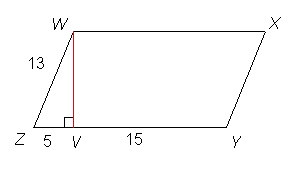Lesson: Geometry - 27
Areas Of Quadrilaterals
[Page 27 of 30]

All five formulas on the list above are useful to know, but you can really get by with only three formulas. First, you don’t need a separate formula for the rectangle because a rectangle is a parallelogram, and thus you can use the parallelogram formula for a rectangle. (The rectangle formula is on the list, however, because it’s such a basic one — which you’ve known since at least middle school — and because it works a bit differently than the parallelogram formula.)
And second, because the square is a special type of four quadrilaterals — a parallelogram, a rectangle, a kite, and a rhombus — you don’t really need a special area formula for a square.

The area of a parallelogram is the length of its base times the length
of its height. We find the height the same way that we found the height
for triangles. The height is the distance from the uppermost angle to
the base line.

For parallelogram WXYZ, the length
of its base is 5+15=20.
By dropping a perpendicular to the base
to get the height, we have made a right triangle. Do the lengths of one
leg and the hypotenuse look familiar? We have one of our special triangles:
the 5:12:13 Pythagorean ratio. This gives us our height, since we know
that VW must be 12.
Now we can find the area, which is 20
× 12 = 240.
Next to display next topic in the chapter.
Test Prep Lessons With Video Lessons and Explained MCQ
Large number of solved practice MCQ with explanations. Video Lessons and 10 Fully explained Grand/Full Tests.